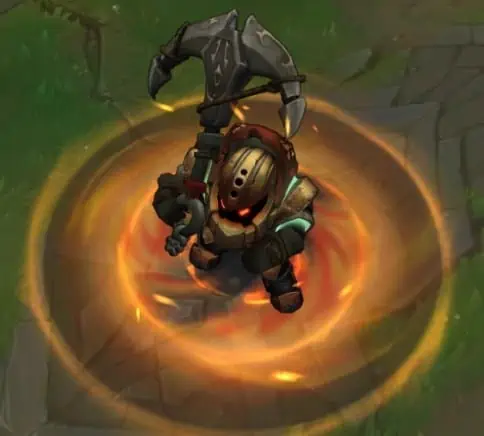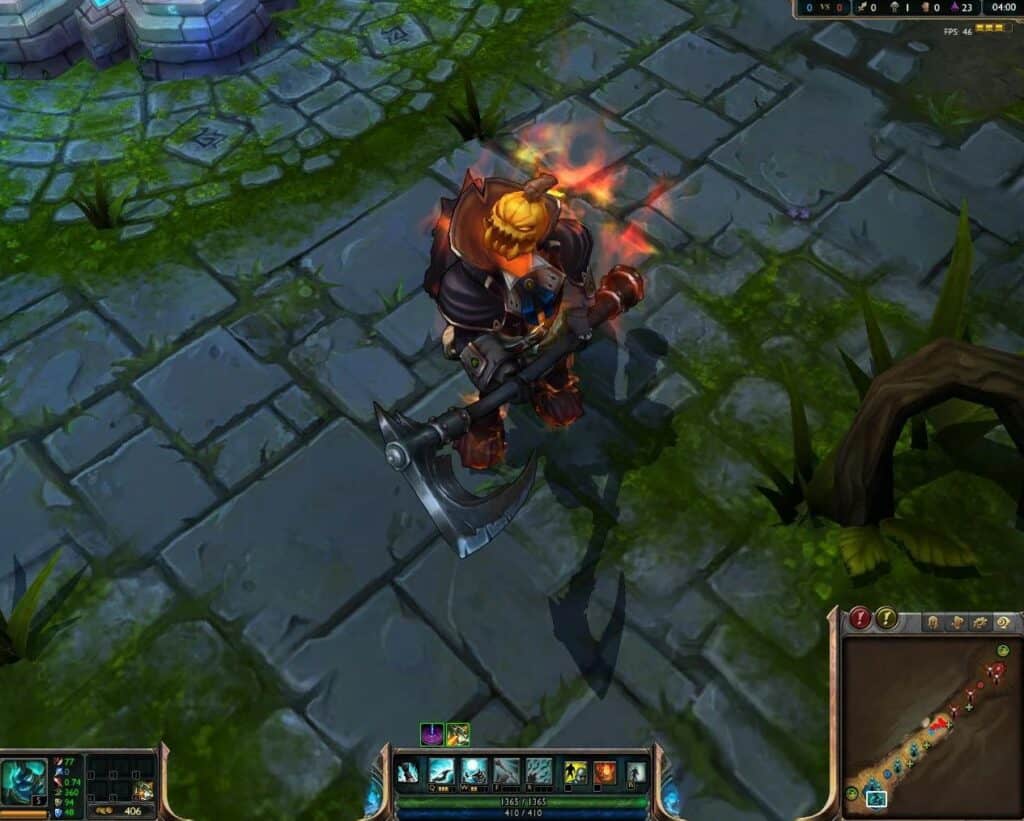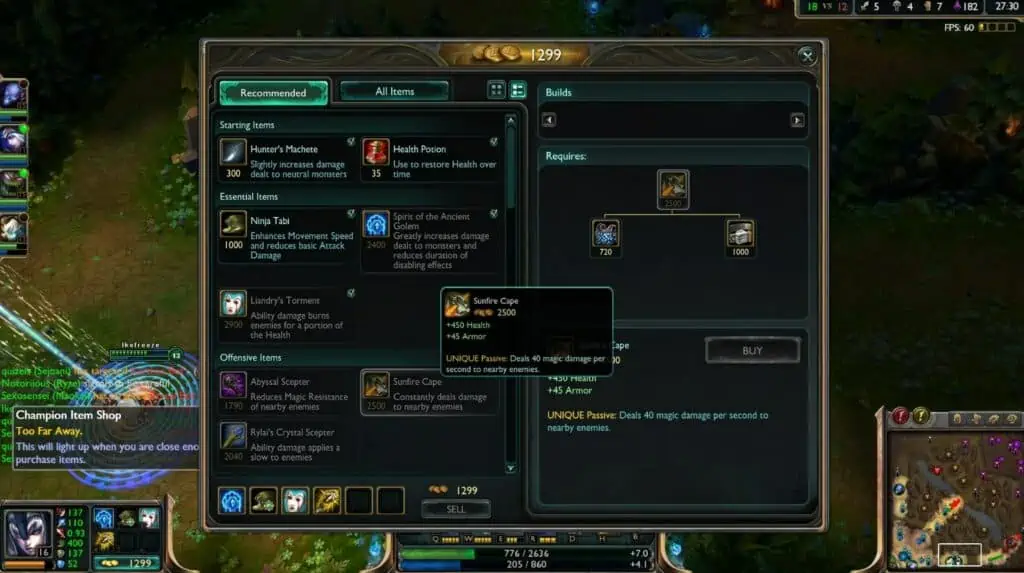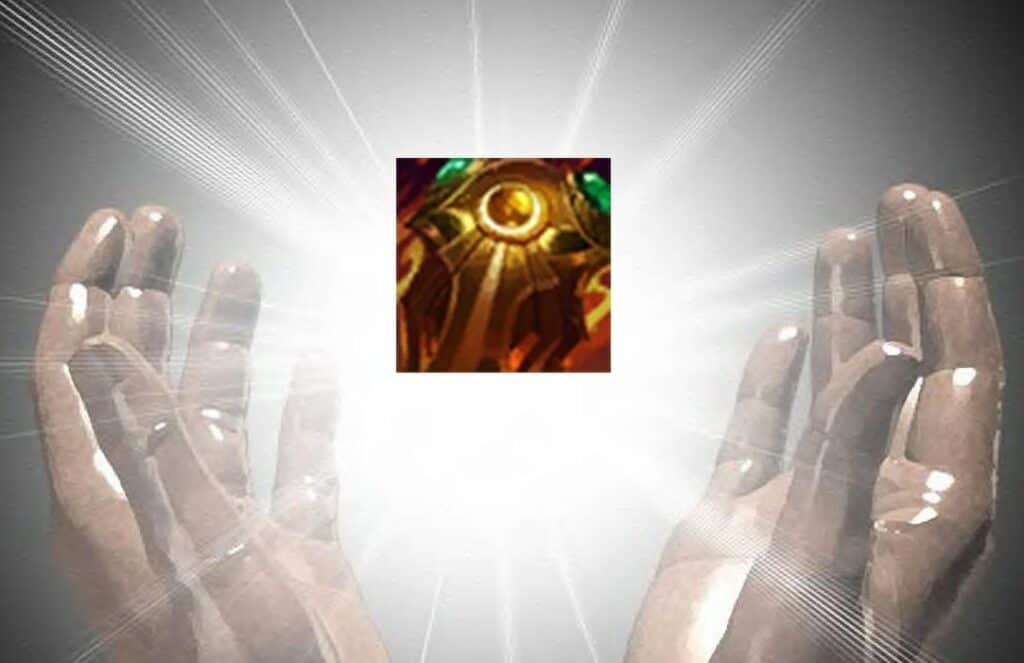- Blue Essence Emporium Guide - May 26, 2022
- League of Legends Houses - May 4, 2022
- League of Legends Pets - May 2, 2022
Sunfire Cape was an item that was eventually replaced by Sunfire Aegis. Both of these objects were tailor-made for tanks and had a potent passive ability called Immolate that burns all opposing units within a radius.
The cape shares some similarities with Dota’s Radiance. Both items should help you farm faster while increasing your presence in team fights. Unlike Radiance, which was mostly an offensive item, Sunfire Cape had strong defensive capabilities with descent passive AOE damage that scales with levels and health.
In this Sunfire Cape Guide, we will review the item, its strengths, and how players utilized it.
Key Info Up Front
Sunfire Cape was a strong defensive item that would increase the champion’s teamfight presence. Due to its Immolate passive, the enemies were forced to target you, despite the fact that you were one of the tankiest opponents.
Sunfire Cape Basic Info

As you can presume, Sunfire Cape shared some traits with other defensive items. You could compare it with Randuin’s Omen, Cinderhulk, and Dead Man’s Plate. It was classified as legendary, and while its stats could stack with one another, the Immolate effect could not (at least, not on the same champion).
Sunfire Cape had the basic cost of 2,750 gold, and you could sell it at 1,925 gold. To build Sunfire Cape, you would require Chain Vest for 800 gold (300 gold for Cloth Armor, and 500 gold for a recipe), Ruby Crystal for 400 gold, Bami’s Cinder for 1,100 gold (two times Ruby Crystal at 400 each, and a 300-gold recipe), and a Sunfire Cape Recipe for 650 gold.
Sunfire Cape Stats and Uniques
Sunfire Cape provided 425 health and 60 armor. Unfortunately, its base stats weren’t that good, providing a gold efficiency of 84.85%. The thing that made Sunfire Cape worth your while was its passive Immolate.
This effect could dish 26 to 43 magic damage, depending on your level, in an area around the champion. It had a 325 radius, which could increase by 100% with an extra unit’s size. A tick of damage would affect surrounding units every second. What’s even better, Immolate had a secondary component.
When you hit an opponent with an immobilizing spell or ability, you would dish 26 to 43, depending on your level, plus 4% bonus health as magic damage in a radius of 400 units, which could increase by 100% with an extra unit’s size. The effect looked like a fire nova, and it had a cooldown of 12 seconds.
Another amazing thing about Immolate is that it would deal extra 50% damage to monsters and minions. This made it a great first-item choice, as it would allow scaling for champions who otherwise don’t have a way to farm quickly.
How Did Immolate Work?

Immolate had a few cool interactions. For example, if you managed to increase the champion’s model size, you could also increase the burning radius. At the same time, the effect’s radius couldn’t be lowered by reducing the champion’s size.
The burn aura was considered default damage for purposes of bonuses and other item/ability interactions.
When you burned opposing champions near their turrets, you would pull turrets aggro. This could be really tricky if you’re underleveled, underfarmed, and can’t tank turret shots. The cooldown of Immolate’s second ability could be lowered by things such as Indigenous Hunter.
While the effect work in a radius (like an aura), it wasn’t considered a debuff or an aura. In other words, you could stack the effect, but only if several enemies had Sunfire Cape. The AOE damage resembled Amumu’s Despair or Alistar’s Trample.
Given that the damage was classified as magical, it would benefit all the effects that otherwise boost magical damage. In other words, it would synergize well with magic resistance reduction or magic penetration. Many players would build Sorcerer’s Boots and/or Abyssal Mask with Sunfire Cape.
Sunfire Cape History of Changes
As mentioned, this cape resembled Dota’s Radiance, so it wasn’t surprising when it was introduced as one of the first items in the game. The first recorded change to the magical object came on the 18th of April, 2009, when the aura damage went from 40 to 50. During the same patch, Riot reduced its total cost from 900 to 600.
After just a few weeks, the developers made additional changes to Sunfire Cap, increasing its cost from 600 to 800 and reverting its previous damage buff back to 40. The cape’s recipe changed on May the 9th and would now require Giant’s Belt instead of two Ruby Crystals. The armor gain was nerfed from 60 to 50.
Riot continued tinkering with the item, dissatisfied with its strong impact on the game. They reduced health from 500 to 450 and its armor from 50 to 45. However, the changes were too much, so they reduced its cost in one of the subsequent patches from 1,000 gold to 700 gold. The cost was increased to 800 in version 1.0.0.107 when they classified the burning effect as a unique.
In the following few patches, Riot fixed a bug that was plaguing Sunfire Cape. Unlike most other items that were completely changed in the 1.0.0.152 version, Sunfire Cape only received a minor tweak to its price going from 2,610 gold to 2,500 gold.
The developers were satisfied with the item at this point, and they barely changed anything until version 5.5. The only notable alterations had to do with aura visual and item icon. Also, they changed how aura damage was calculated, becoming a level-based effect.
Patch 5.5 Changes and Onward

Instead of utilizing Giant’s Belt, the cape now required Bami’s Cinder. Nevertheless, the total price remained the same. The burn aura was now classified as unique passive Immolate.
During patch 6.1, the developers increased the item’s armor gain from 45 to 50. In patch 6.3, Immolate effect was buffed so that it deals an extra 50% to monsters and minions. Its base damage would range from 39 to 65, depending on a character’s level. During patch 6.9, Sunfire Cape’s total cost rose from 2,700 gold to 2,900 gold.
Version 7.9 brought several major changes to the item. First, the health gain was reduced from 500 to 425, while the armor boost went from 50 to 60. Immolate received a major nerf; its damage went from 26 – 43 (depending on champion’s level) to 12 – 29 (depending on champion’s level).
The damage to monsters and minions was buffed, though. Sunfire Cape would previously dish from 39 to 65 damage to these units, and after the patch, it would deal from 36 to 87 magical damage. The effect’s radius was decreased from 400 to 325.
Patch 7.13 Changes and Onward
In this particular patch, the item recipe was slightly altered. It now included Ruby Crystal, but the total price remained unchanged. Sunfire Cape could be upgraded to Forgefire Cape (Ornn’s upgrade) in version 7.17.
The aura damage was once again altered in patch 7.24. Riot reverted it back to the previous 26 – 43 magic damage, based on the champion’s level. Similarly, the damage to minions and monsters was reverted to 39 – 65 (damage prior to version 7.9). Sunfire Cape also experienced a small alternation in terms of aura range, making it an effect that worked from edge to center instead of from center to center.
During version 9.1, Riot made a few changes to Forgefire Cape. Its cost went from 3,900 to 2,900, and you could only use it if the item was created by Ornn (for an ally or himself). In the following patch, Sunfire Cape’s cost went from 2,900 gold to 2,750 gold. In version 9.7, the developers added a display that showed how much damage Immolate did to each one of the opponents.
Patch 9.8 provided small buffs to Forgefire Cape, increasing the armor gains from 90 to 100 and health from 625 to 750.
Patch 10.4 Changes

During patch 10.4, the item has received a major buff. From this point onward, it would cause a secondary effect each time an enemy is targeted by an immobilizing spell or ability. When this happened, it would cause 26 to 43 plus 5% bonus health extra magical damage while also releasing a burning nova. This effect would deal 50% extra damage to monsters and minions.
After this patch, there were a few minor alterations to the item prior to being canceled. Given that the item felt really strong after the 10.4 update, the developers had to perform a few quick fixes. They immediately increased the passive effect’s cooldown from 10 to 12 while also reducing the health ratio from 5% to 4%.
Riot also fixed two bugs. Heimerdinger’s turrets would jumpstart Immolate effect (something that wasn’t planned). They also fixed a bug where Poros would trigger Immolate on the Howling Abyss map.
Although the item was eventually removed from the game, it did receive a successor. In 10.23, the legendary Sunfire Cape item was replaced by mythic Sunfire Aegis, thus prolonging its life in League of Legends.
The Differences Between Sunfire Cape and Sunfire Aegis

Like with all legendries turned mythic, there are a lot of similarities between Sunfire Cape and Sunfire Aegis. As you can presume, both of these items revolve around Immolate’s unique passive, burning enemies within a radius. But let’s start from the top.
Sunfire Cape cost 2,750 gold, while Sunfire Aegis cost 3,200 gold. As for the stats, Sunfire Cape gave its wearers 60 armor and 425 health, compared to Sunfire Aegis’ 35 armor and 350 health. However, this item also provides 35 magic resistance and 20 ability haste, making it easier to resist spells while quickening your own.
Both items are ideal for AP tanks. Given that Sunfire Aegis is a mythic, it provides a significant bonus when paired with legendries, giving a champion 50 extra health, 5% tenacity, and 5% movement slow per legendary item in inventory.
When it comes to passive uniques, the old version of Immolate was much better on characters who have immobilizing abilities, while the new unique gets better after auto-attacking an enemy several times over.
Immolate Old and New Stats

Sunfire Cap’s version of Immolate dealt from 26 to 43 magic damage each second based on character level. It worked within 325 radii, which could be increased by 100% with the champion’s size.
If you hit an immobilized target, you would deal from 26 to 43 magic damage plus 4% bonus maximum health while releasing a flame nova around you, punishing enemies in 400 radii (plus 100% character’s size) for the same damage. The effect had a 12-second cooldown.
All of this damage would be 50% more potent against monsters and minions.
The new Immolate effect worked a bit differently. The passive would only activate if you deal or take damage to opponents. Immolate dishes from 12 to 30 (depending on character’s level) plus 1% bonus health magical damage per second to all opponents within a 325 radius.
Like with the old Immolate, the area of effect can increase if you increase the character’s model size. Burn dealt extra 150% damage to monsters and 25% extra damage to minions. Furthermore, the effect could instantly eliminate minions if they needed another tick of damage to die.
Although this effect seems rather underwhelming when compared to the old version, it actually gets better when you engage opponents. Basically, you will gain a 5-second stack whenever you damage an enemy character or an epic monster. You can get up to 6 stacks, and each one of them will increase the Immolate damage by 12% (for a total of 72%).
Once you get max stacks, your auto-attacks will start exploding in an area around you, causing Immolate burn to the nearby opponents for 3 seconds.
FAQs
Question: What does Sunfire Cape do?
Answer: Sunfire Cape was a strong defensive item that provided health, armor, and a strong AOE presence. Although its defensive stats were really nice for tanks, most people took it for its Immolate effect. This unique passive dealt 26 to 43 magic damage in a radius around the wearer. Immolate had another passive effect that would cause your immobilizing abilities to deal extra damage based on health and character level.
Question: Is Sunfire Cape a good item?
Answer: If you take a look at the gold efficiency, this doesn’t seem like a particularly strong piece of armor. It was 84.85% efficient, which placed it in the lower half of all the items. However, keep in mind that the gold efficiency is only calculated on basic stats. If we also consider the Immolate effect, you quickly realize that the item is much stronger than the data suggests. So much so that it was regarded as utterly broken in a few patches.
Question: Does Sunfire Cape stack?
Answer: While the Immolate effect doesn’t stack on one champion, you can have Sunfire Cape on several characters causing massive damage in an area.
Sunfire Cape Guide: Last Considerations
During its life, Sunfire Cape often felt overpowered. It was a great defensive item that provided users the necessary tankiness, but it also did damage in a radius. When wearing Sunfire Cape, low damage tanks could no longer be ignored. It was especially great on characters such as Amumu and everyone else who already had consistent AOE damage.
What’s even better, this item scaled with health. So, it would actually stimulate purchasing of defensive items. Eventually, Sunfire Cape was replaced by Sunfire Aegis in version 10.23. The developers didn’t necessarily want to remove the item. Instead, they honored it by upgrading it to mythic.

